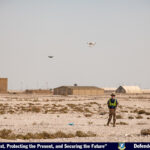AL UDEID AIR BASE, Qatar — The 379th Expeditionary Security Forces Squadron and 379th Expeditionary Civil Engineer Squadron Explosive Ordnance Disposal team partnered for a counter-small unmanned aerial systems training event at Al Udeid Air Base, Qatar, Dec. 11, 2020.
Small UAS are a concern for bases throughout the U.S. Central Command area of responsibility. As with any threat to the installation, the 379th ESFS is prepared to detect and defend with the c-UAS team.
For security forces, drone defense starts in the base defense operations center. The instant someone identifies a drone, either visually or through detection systems, first responders are tasked and deployed with “Dronebusters.” These devices can jam commercial drones by disrupting the signal between the UAS and the operator.
Once the drone is grounded and incapable of launching again, 379th ESFS Defenders treat it like an unexploded ordnance.
“You don’t know what it actually has on it explosives-wise, so you always treat it as once it’s on the ground to be safe,” said Master Sgt. Roberto Macias, c-UAS program manager for the 379th ESFS.
Security forces Airmen begin to establish safety zones around the downed UAS and a call is placed to EOD. Each recovered drone asset is treated as suspicious and an emergency response is warranted in every case. Training together helps ensure the tactics, techniques and procedures that both entities use are seamlessly integrated as they both respond to the threat.
“Our role in such a response is to determine if it is hazardous,” said Senior Master Sgt. Joseph Leslie, EOD flight superintendent. “We have spent decades perfecting hazardous device diagnostic techniques as well as sharpening our threat assessment and mitigation proficiencies. Due to the nature of UAS responses, we are able to translate those capabilities directly into how we tackle this latest threat.”
Unique training aids are included with the typical response equipment already in place. EOD uses their resources, such as an F6-A robot, EOD-10 bomb suit and XRS-150 X-ray generator, to respond to the UAS. However, rather than potentially use a more expensive drone for training, the c-UAS team uses the Al Udeid Innovation Lab 3D printer to create a shell. Leslie then modified the device to make it a more realistic training aid for his team to examine.
“I outfitted the drone with a training improvised explosive device with a functioning circuit, but simulated explosives,” he said. “Any opportunity to enhance our training, we take. Being able to do it with security forces and a fleet of drones was an added bonus that led to a better understanding of what each of our respective capabilities are and how we can continue to make those capabilities the best that they can be.”
As the 379th ESFS continues training with other base entities to address the UAS threat and refine the c-UAS response, they look to incorporate additional agencies so their exercises have a broader scope.
“We try to take our c-UAS systems operators and use them as drone pilots,” said Macias. “They become the bad guy so they can understand the system they operate in BDOC and also see the threat in the field, understand the system and what it would do. However, our goal is for more people around the base to be familiarized with what we do. Schedules can be a barrier to training and coordination, but the end result with just EOD allowed both squadrons to take away lessons that we can troubleshoot and resolve so that we’re prepared for a real-world response.”
Having other emergency response Airmen involved would allow the team to get a better understanding of the full scope of reacting to a situation involving a drone. Practicing for what real-world challenges might be encountered is an important step in the process.
“Although UAS is a newer threat, the concepts used to mitigate the associated hazards are ones that we are all too familiar with,” said Leslie. “This partnership came about primarily through the joint nature of our emergency response mission. We rely on the professionalism and expertise of each other to ensure the emergency is rectified as quickly and as safely as possible.”
By Tech. Sgt. Brigette Waltermire, 379th Air Expeditionary Wing
Published January 20, 2021

